If you're just looking for a quick eyeball test, you could simply draw a heat map of each variable's presence/absence against each other variable. For example:
library(tidyverse)
# Example Questionnaire data
# All uncorrelated, except for Q4 NAs against Q1 values
set.seed(1)
Q1 <- sample(c(1:10, NA), 100, replace = TRUE)
Q2 <- sample(c(1:10, NA), 100, replace = TRUE)
Q3 <- sample(c(1:10, NA), 100, replace = TRUE)
Q4 <- sample(1:10, 100, replace = TRUE) %>% {ifelse(Q1>5,.,NA)}
questionnaire <- tibble(Q1, Q2, Q3, Q4)
questionnaire %>%
# for each existing column, add a logical column indicating presence of NA
{mutate(., across(colnames(.) %>% {setNames(., paste0(.,"_na"))}, ~ as.integer(is.na(.x))))} %>%
# generate plot of pairwise correlations
DataExplorer::plot_correlation(type="continuous", cor_args=list(use="pairwise.complete.obs"))
Here I've replaced your Q4 with a variable that will be NA wherever Q1 is 6+.

Just looking at this heat map shows immediately that the data is very much not MAR: NAs in field Q4 are very highly correlated (-85%) with the values in field Q1. Obviously that's no substitute for a full statistical test, but depending on your use case (data exploration vs formal analysis) it might be good enough.
A more formal approach, taken from the DataCamp course that LC-scientist mentions, would be to fit a logistic regression model for each field's NA-indicator variable against each of the other fields in turn, then look at the p-value. This has the obvious issue that it will only capture linear correlations - if variable A's NAs are conditional on variable B squared then you're out of luck - and the slightly less obvious issue that the p-value threshold needs to be adjusted to avoid replicating an XKCD cartoon.
(I'm also slightly wary of considering this a true formal test. My gut feel is that you really need a proper joint test rather than merely repeating pairwise tests, although I'm not aware of one. For this post, I'll assume that the methodology is basically valid.)
The p-value issue can be fixed using a Šidák correction: replacing the threshold α with 1-(1-α)1/#tests. Or conversely - and what I'll do here - replacing the calculated p-value with 1-(1-p)#tests, so the viewer can apply whatever threshold they like. For N variables there will be N(N-1) tests.
Code for this - appended to the bottom of the above - is as follows:
# Get the p-value of logistic-regressing Vdep against Vreg
get_p <- function(data,Vreg,Vdep)
# Usage: get_p(df,"Q1","Q2_na") to test the dependency of Q2_na on the regressor Q1
glm(formula=as.formula(paste0(Vdep," ~ ",Vreg)),
family="binomial", data=data, na.action="na.omit") %>%
{ coef(summary(.))[2,4] } %>% # warning: summary.glm returns 95% for a 5% p-value
return()
# Apply Sidak adjustment to p-value
# Expressed as 5% = significant, per the Wikipedia page
adj_sidak <- function(pval, Nvars) return( 1-(1-pval) ^ (Nvars*(Nvars-1)) )
questionnaire %>%
# for each existing column, add a logical column indicating presence of NA
{mutate(., across(colnames(.) %>% {setNames(., paste0(.,"_na"))}, ~ as.integer(is.na(.x))))} %>%
{ suppressWarnings( {
ddd <- .
ddd %>%
# extract original column names
colnames() %>% str_subset(pattern="^((?!_na).)+$") %>%
# create dataframe of non-equal column name pairs
{expand.grid(.,.)} %>% filter(Var1!=Var2) %>%
# for each pair, calculate the p-value from regressing 2nd onto 1st
# (before and after Sidak correction)
mutate(pval = mapply(get_p,
.$Var1, Vdep=paste0(.$Var2,"_na"),
MoreArgs=list(data=ddd)),
pval_adj = 1-adj_sidak(1-pval, ncol(ddd)/2*(ncol(ddd)/2-1)))
} ) } %>%
# convert results to matrix-style table
select(-pval) %>% pivot_wider(names_from=Var2, values_from=pval_adj) %>%
# clean up formatting
arrange(Var1) %>% column_to_rownames("Var1") %>% mutate_all(~ sprintf("%.2f%%",.x*100))
And the result looks something like this:
Q1 Q2 Q3 Q4
Q1 NA% 0.00% 0.00% 78.75%
Q2 0.00% NA% 0.00% 2.54%
Q3 0.00% 0.00% NA% 0.00%
Q4 100.00% 0.00% 0.00% NA%
Note that only the Q1-Q4 connection has a p-value less than 5% (expressed by R as 1-p=100.00%), and only in the direction from Q1 to Q4.
Going the other way round, there is visibly (78.75%) some kind of connection - the "backwash" from conditioning Q4's NAs entirely on Q1 - and we would have seen a spuriously significant p-value (99.82%!) if we hadn't applied the Šidák correction. The small Q4-Q2 link (2.54%) is just random chance, but again would have looked a lot more significant (97.26%) without the correction.
